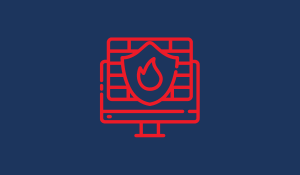Application Control: Robust Security Solution for Your Company
The number of attacks is constantly increasing and attackers are becoming more and more targeted and tricky. They specifically exploit the human...
7 min read
 DriveLock
Mar 13, 2025 10:30:01 AM
DriveLock
Mar 13, 2025 10:30:01 AM

While data encryption forms a fundamental layer of protection, ensuring only trusted applications can access and process encrypted data is equally vital. This is where application whitelisting comes into play. Securing data at rest is vital, particularly in sectors like healthcare, manufacturing, and critical infrastructure, where breaches can have severe consequences.
| TABLE OF CONTENT |
But what about controlling who—or rather, what—can actually unlock that vault? Simply encrypting files leaves a gap. To close it, we need to talk about application whitelisting, a method that precisely dictates which programs are granted access to your most valuable information.
Essentially, application whitelisting is a security practice that allows only pre-approved applications to run on your systems. Instead of trying to identify and block malicious software (which can be a never-ending battle), whitelisting flips the paradigm. It establishes a "default deny" policy, meaning everything is blocked unless explicitly permitted.
Think of it like a VIP list for your digital environment. Only applications on this list, verified and trusted, are granted access. This significantly reduces the attack surface, as unknown or unauthorized software cannot execute, even if it bypasses other security measures.
Understanding the inner workings of application whitelisting is key to appreciating its effectiveness. It's not just a simple on/off switch; it involves a systematic process of identifying, authorizing, and monitoring applications. To truly secure your environment, you need to know how these controls are implemented and enforced. Here's a step-by-step look at how application whitelisting operates: The process involves several key steps:
Comprehensive Application Inventory and Analysis:
Rule Creation and Whitelist Development:
Policy Enforcement and Control:
Ongoing Monitoring and Maintenance:
Exception Handling and User Feedback Loops:
Organizations seek a defense that anticipates and neutralizes risks before they materialize. This is where application whitelisting shines, providing a robust layer of protection that goes beyond traditional security models. Here’s a closer look at the key advantages:
Superior Data Shielding: By strictly controlling which applications execute, you drastically reduce the potential for malware, ransomware, and other malicious software to infiltrate your systems. This is paramount for protecting sensitive encrypted data, especially in environments where data integrity is non-negotiable. This control also minimizes the risk of data exfiltration, as unauthorized programs cannot access or transmit sensitive information.
Shrinking the Attacker's Playground: Application whitelisting effectively reduces the attack surface by limiting execution to only pre-approved applications. This makes it significantly harder for attackers to exploit vulnerabilities, as they are confined to a very narrow set of allowed programs. This creates a much more predictable and manageable environment, allowing IT teams to focus their resources on monitoring and securing known, trusted applications.
Strengthening Regulatory Adherence: Many regulatory frameworks, particularly in highly regulated sectors like healthcare (e.g., GDPR, HIPAA) and critical infrastructure (e.g., NIS Directive), mandate strong security controls. Application whitelisting provides a powerful tool for meeting these requirements, demonstrating a commitment to data protection and compliance. It provides auditable logs of what applications were running, which is very helpful for any compliance auditing.
Building a Defense Before Impact: Unlike traditional antivirus solutions that rely on signature-based detection, application whitelisting takes a proactive stance. By preventing unauthorized applications from running, it stops threats before they can cause damage. This proactive approach minimizes downtime and disruption, ensuring business continuity even in the face of sophisticated cyberattacks.
Neutralizing Unknown Threats: Zero-day attacks, which exploit previously unknown vulnerabilities, pose a significant challenge to traditional security measures. Application whitelisting effectively mitigates this risk by blocking all unknown applications, regardless of their nature. This provides a critical layer of defense against emerging threats, ensuring that even novel malware cannot execute on your systems.
Improved System Performance: By preventing unnecessary or unauthorized applications from running, application whitelisting can reduce system resource consumption. This can lead to improved performance and stability, especially in environments with limited resources. This also reduces the amount of background processes that are running, which means less network traffic, and less CPU usage.
Simplified Software Management: With a clearly defined whitelist, IT administrators gain greater control over the software environment. This simplifies software updates, patch management, and overall system maintenance, reducing the risk of conflicts and errors. It also reduces the amount of shadow IT that can happen, where employees install unapproved software.
While application whitelisting offers significant security advantages, it's essential to acknowledge the practical hurdles involved in its implementation and maintenance. Successful deployment requires careful planning and a realistic understanding of the potential challenges. Overcoming these obstacles is crucial for realizing the full benefits of this robust security strategy. Here's a breakdown of the key considerations:
The Initial Inventory Bottleneck: Building the initial whitelist is often the most demanding task. Large organizations with diverse software ecosystems face the challenge of meticulously cataloging every legitimate application. This process demands significant time and resources, particularly when dealing with complex or decentralized IT infrastructures. This process also requires careful analysis of dependencies, to make sure that allowing one program does not break another.
The Demands of Continuous Vigilance: Application whitelisting is not a one-time effort. Maintaining an up-to-date whitelist necessitates ongoing monitoring and adjustments. Software updates, new application deployments, and evolving business requirements all necessitate regular revisions. Automation tools and streamlined workflows are essential for managing this continuous maintenance, preventing the whitelist from becoming outdated and ineffective.
Balancing Security and User Experience: Restricting application execution can inadvertently disrupt user workflows if legitimate applications are blocked. This requires careful planning, thorough testing, and clear communication with end-users. Implementing a "learning mode" during the initial phase can help identify legitimate applications that may have been missed during the inventory process, minimizing user disruption.
Navigating Legacy System Compatibility: Older applications, especially those without digital signatures or those relying on outdated technologies, may pose compatibility challenges. This can require careful evaluation and, in some cases, the implementation of workarounds or the replacement of legacy systems. Virtualization and application wrapping are possible solutions to this problem.
The Risk of Overly Restrictive Policies: If the whitelisting policy is too restrictive, it can impede legitimate business operations. Finding the appropriate balance between security and usability is paramount. This requires careful consideration of business needs and a thorough understanding of the organization's software environment. Regularly reviewing and refining the policies, based on usage data and feedback, is vital.
Challenges in Cloud and SaaS Environments: Integrating application whitelisting with cloud-based applications and Software as a Service (SaaS) solutions presents unique challenges. Traditional whitelisting methods may not be directly applicable, requiring the adoption of cloud-native security controls and APIs. The dynamic nature of cloud environments, with frequent updates and changes, necessitates robust integration with cloud security tools to ensure consistent application whitelisting enforcement.
In the ongoing struggle against cyber threats, organizations often grapple with choosing the most effective security approach. While both application whitelisting and blocklisting aim to control software execution, they operate on fundamentally different principles. Understanding these distinctions is critical for selecting the strategy that best aligns with your organization's risk tolerance and security objectives. Here's a comparative breakdown:
Default Stance: Functions on a "default allow" basis. All applications are permitted unless specifically identified as malicious and blocked. This approach is more permissive.
Threat Mitigation: Primarily defends against known threats. Its effectiveness is limited against zero-day attacks, as new malware can bypass the blocklist until it's identified and added.
Maintenance Effort: Generally easier to implement initially, as it doesn't require an exhaustive inventory. However, it necessitates continuous monitoring and updating to keep pace with emerging threats.
User Impact:Typically has less initial user impact, as most applications are allowed. However, it can lead to unexpected disruptions if new malware bypasses the blocklist.
Security Posture: Provides a reactive security posture. While it can mitigate known risks, it's less effective against sophisticated and evolving threats. It is more suitable for less sensitive environments where security is balanced with user experience.
Default Stance: Operates on a "default deny" principle. Only applications explicitly approved are allowed to run. This creates a highly restrictive environment.
Threat Mitigation: Provides robust protection against both known and unknown threats, including zero-day attacks. By blocking everything not explicitly permitted, it minimizes the risk of new malware executing.
Maintenance Effort: Requires significant initial effort to build the whitelist and ongoing maintenance to keep it updated. However, once established, it offers a more predictable and controlled environment.
User Impact: May initially cause more user disruption, as legitimate applications might be inadvertently blocked. Careful planning and testing are essential to minimize this impact.
Security Posture: Offers a strong, proactive security posture. It's ideal for organizations with high security requirements, such as those in regulated industries or those handling sensitive data.
| Merkmal | Application Whitelisting | Blocklisting |
| Security level | Very high | Medium |
| Administrative expenses | High | Medium |
| Protection against zero-day attacks | Yes | No |
| Flexibility for users | Limited | High |
Allowlisting is considered significantly more secure, as it provides a much stronger defense against unknown threats. Blocklisting, while easier to implement, is less effective against sophisticated attacks.
Application whitelisting is a powerful security measure that protects organisations in critical sectors such as healthcare and industry from cyber threats. Although it requires administrative effort to implement, the benefits outweigh the costs in terms of increased security, better system control and reduced risk from unknown malware.
Especially in combination with other security strategies such as encryption and network segmentation, application whitelisting can be a crucial part of a comprehensive cybersecurity strategy.

The number of attacks is constantly increasing and attackers are becoming more and more targeted and tricky. They specifically exploit the human...
.png)
June 2024 marked the 11th anniversary of the Harvard Faculty Club's Maximize Your Board's Potential program. It was the second time I've had the...

Are you ready to fortify your digital defenses and safeguard your network from cyberattacks? Look no further than the network firewall. A formidable...